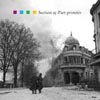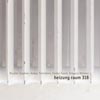- Administrator
- Albums and Singles
 A few months back, while reviewing Pole's recent album, I commented that ~scape's relevance was diminishing in tandem with the tragic creative downfall of its once-trailblazing founder. However, perhaps I spoke a bit prematurely, given the latest unique and luxurious sounds from this dubsonic bulwark for the otherwise sagging imprint.
A few months back, while reviewing Pole's recent album, I commented that ~scape's relevance was diminishing in tandem with the tragic creative downfall of its once-trailblazing founder. However, perhaps I spoke a bit prematurely, given the latest unique and luxurious sounds from this dubsonic bulwark for the otherwise sagging imprint.
Depending on who you ask, Montreal's Scott Monteith represents either the tail end of ~scape's mind-altering first wave or the hopeful beginning of its much less memorable second. Stefan Betke's label first hit the scene when dub techno rode a feverish high, producing near-classic releases from artists like Kit Clayton and Jan Jelinek, but it later floundered with motley hit-or-miss offerings that departed, at times dramatically, from its archetypal style. Deadbeat, however, maintained a certain consistency, long after most of his labelmates grew weary of such post-Jamaican trappings. Grounded in dub's naturally spacious environs, Journeyman's Annual takes his sound to exciting places both old and new.
Opener "Lost Luggage" commences with swirling atmospheres, echoing snares, and sparse instrumentation that seems just a few inches from dubstep, until a gorgeous lead melody appears that leaves little doubt that Monteith has been listening to artists like Kode9 and Loefah. Similarly, deep and groovy "Melbourne Round Midnight" eases through with a percussive one-drop plonk and evolving currents of intricate sound design. While an entire album in this chilled digi-dub vein would undoubtedly be well received, the rest of the disc shows the artist instead making progressive strides with dancehall. He recruits Jah Cutta from his native Canada for the rowdy and raunchy "Gimme A Little Slack," a single-worthy cut that would sound killer over a proper soundsystem. With the sound clash in mind, Monteith versions the track for "Gimme A Little Dub," fleshing out the original riddim a bit with some signature bleeps and glitchy clicks. Recalling Adrian Sherwood's excellent 2006 solo album, "Where Has My Love Gone" and "Turbulence" build basic yet infectious techno structures around its island rhythm, generating a pleasant hybrid sound.
Hardly a purist, Monteith eagerly and methodically blends styles without hesitation. "Refund Me" has the grimey Bubbz spitting verses a over a crunchy Jamaican loop of overcooked electronics while Moral Undulations contributes his anti-capitalist spoken word poetry to the minimal yet firm "Deep In Country." The album finishes strong with a bonus remix of the ever-eclectic Saul Williams' "Black Stacey," remodeling the opinionated rapper's confessional original into an offbeat yet oddly tenacious composition and verifying the cogency of Deadbeat as a viable and valuable producer.
samples:
Read More
- Administrator
- Albums and Singles
 One of the original Factory bands returns after a 21 year silence with a new album that captures the classic post-punk feel with modern day trappings. While some elements of nostalgia from that "classic" age creeps in, it still feels fresh, current, and fascinating.
One of the original Factory bands returns after a 21 year silence with a new album that captures the classic post-punk feel with modern day trappings. While some elements of nostalgia from that "classic" age creeps in, it still feels fresh, current, and fascinating.
Part-Primitv manages to up where the previous material left off, which is no small feat given the long break the band had. S25 aren’t afraid to stick with what worked for them in the past, but do not come across as being stuck in history or unwilling to try new things. The angular, yet catchy, post punk is here ("Gene," "Cry") as are electronic based tracks ("Roma," "Power Base"). Some of the nostalgia isn't quite as welcome, however. “Dream” (one of two tracks featuring vocals from late S25 member Jenny Cassidy) is almost TOO deeply rooted in its techno pulse beat and club synthesizers, could be about any nameless late '80s/early '90s techno pop band. It's a good track, but it does sort of stick out as a time capsule of an age many would like to forget.
Other tracks take the vintage trappings and recontextualize them into a completely different beast, such as the New Edition R&B synths and hip-hop drum machines that are the building blocks to the punk pop of "Better Make Your Mind Up." Some parallels can also be drawn to early contemporaries The Fall, specifically the garage drums and crunchy bass-centric tracks like "Can't Let Go" and "Nick." Sometimes the influences are almost disturbingly blatant, like the bass line lifted explicitly from Joy Division's "Transmission" for "Gene" (though in this case meshed with a rockabilly guitar riff that makes us dance differently than "to the radio"). The more conventional pop tracks, like the analog synths and acid house tinges of "Poppy Fields" show what New Order should have done after Technique—all day-glow neon and Ibiza beach parties—while the electronic strings, acoustic guitar, and '60’s pop vocals of "She's So Pretty" are pure foot tapping saccharine.
Maybe due to the fact that the core members remained the same from the early days of the band, Section 25 were able to rise above the unenviable task of writing, recording and releasing material after 21 years apart. Part-Primitiv is hopefully not just a reunion album, but the first installment of a rejuvenated career.
samples:
Read More
- Administrator
- Albums and Singles
 Four German composers (Stefan Funck, Gregory Buttner, Asmus Tietchens and Nicolai Stephan) had been meeting in Room 318 for years, but the room had a problem. The heating system didn't work, and made odd noises. Surely a distraction, but with artists like these, they made the natural decision: use the odd noises of the radiators and make an album out of them.
Four German composers (Stefan Funck, Gregory Buttner, Asmus Tietchens and Nicolai Stephan) had been meeting in Room 318 for years, but the room had a problem. The heating system didn't work, and made odd noises. Surely a distraction, but with artists like these, they made the natural decision: use the odd noises of the radiators and make an album out of them.
The compilation demonstrates the unique styles of the four artists: even though they all utilized the same five minutes of source material ("Ausgangsmaterial," the final track on the disc), each shaped it into their own different and unique work, making sure that none sound like the other. Stefan Funck's four short pieces differ vastly from one to another, from the minimal slow burn power electronics of "Version Paris-Dakar" (like Whitehouse's "Told" without the misogynist vocals) to what could be initially a cover of Throbbing Gristle's "IBM" done with electric guitar feedback ("Version Vier Hauser"). Buttner's massive contribution, the 14 minute "Heiz" is swathed in reverb and the processed sounds of water dripping, which builds in layers over time, but still retains a distant, subtle tenor that could be a field recording of alien life somewhere deep in the cosmos.
Nicolai Stephan's "Ziehung" is not nearly as complex as the others, based around the sound of a stuttering tape and reversed delays. It's interesting but feels somewhat amateurish compared to the other tracks, and even more so considering it follows avant garde legend Asmus Tietchens' brilliant contribution, "Keine Warme," which is three minutes of rhythmic rattling and noise processed into melody before dropping off into a wind chamber, then coming back in a similarly musical, but with an entirely different sonic pallet for seven more minutes. For this type of music's complexity and obliqueness, Tietchens' piece is extremely accessible and listenable.
As aforementioned, the source material is included as an appendix on the disc, and while we can safely assume it is not something that will make it into heavy rotation, it is good to hear what exactly was used as the proverbial seed for this recording. It is exactly what would be expected: the high pitched whistle of a messed up radiator and the deep gurgling and dripping of water being passed through it.
To be perfectly clear, this is chin stroking music, not something to put on while cleaning the house or entertaining guests. With that in mind, however, it does make for an interesting listen if the proper attention can be paid. It makes for a fascinating example of how many variations can be placed on a simple theme, and just how unique artists of a similar ilk can be.
samples:
- Stefan Funck - Version Paris-Dakar
- Gregory Buttner - Heiz
- Asmus Tietchens - Keine Warme
Read More
- Gary Suarez
- Albums and Singles
Having found fame and respect without prostrating himself for the majors, Armstrong's credentialed catalog stretches collectively over two decades with the influential ska punks Operation Ivy, the consistently credible Rancid, and the unexpectedly plausible Transplants. Released on his own Hellcat Records, a vanity imprint of enduring punk indie Epitaph, A Poet's Life takes its cues from ska and rocksteady legends such as Prince Buster and Toots and the Maytals. Featuring labelmates The Aggrolites as his backing band, Armstrong abandons the studio sheen of his Transplants "supergroup" for these ten stripped down tracks. An genuine passion for reggae music can be easily identified on such songs as the uptempo skankworthy single "Into Action" and the dubbed out instrumental "Cold Blooded." Yet, diluted by Armstrong's distinctly grizzled voice and casual streetwise crassness, the album yields an Americanized, Californicated translation of the Caribbean spirit, evident on the cautionary yet reverential "Oh No". Finding joy amid the hardship, a common lyrical device for reggae vocalists, this paean to Los Angeles couldn't have a more authentic voice if penned by anyone else.
Originally slated for gratis digital release (which allegedly is still planned), A Poet's Life was given a chance as a CD/DVD package for those who wanted physical copies. If the 40-year old Armstrong, longtime contributor to indie music, and Hellcat stick to this admirable promise, it will mean a great deal to those of us who value a thriving independent scene that understands, respects, and caters to the listener as opposed to the shareholder.
Read More
- Administrator
- Albums and Singles
On October 9, 2007 Robert Wyatt is to release his new album and first for Domino.
Read More
- Administrator
- Albums and Singles

Read More
- Administrator
- Albums and Singles

Australian guitarist Tim Catlin and American percussionist Jon Mueller's approach to their instruments is based on their shared interest in the vibration of material and the changes in sound that result in modifying those vibrations. Over a year in the making, Plates and Wires features a series of different situations involving guitars, gongs, snare drums, and bass drum, and their resonant effect upon one another. Plates and Wires was mastered by James Plotkin (Khanate/Phantomsmasher/Khlyst) and is released in an edition of 300 in a 10x10" package featuring artwork from painter Thomas Kovacich. Kovacich's practice of dragging paint with devices over large disused planks of furniture creates a visual cohesion with the layers of milky and gritty sounds heard within the recording.
Read More
- John Kealy
- Albums and Singles
Considering the gorgeous gatefold sleeve that is heavily inspired by the album art of Yes and the ominous King Crimson-esque intro to “Walrus,” it was disappointing that Boris’ take on The Beatles was not a progged out supernova. Even with Merzbow on board to add odd sounds like seagulls and his usual electronic flatulence, this version of “I am the Walrus” kept very close to the original. It ends up sounding like the band were just passing the time at rehearsal rather than reworking a classic. On the opposite side, “Groon” is equally disappointing. Atsuo’s drumming could form the foundations of a traditional Boris epic but Merzbow and the rest of the band do not build on Atsuo’s beats, instead they add a layer of noise that sounds like it was added as an afterthought. At the end of the day, there are so discs released regularly by both Merzbow and Boris that many of them are bound to be filler and Walrus/Groon is one such record.
Read More
Transcendent, esoteric. Skat like vocals govern the first track. The driving thumping train like rhythms collide with each other and derail with frivolity. Circle sounds like a well produced corner shop band that you might find playing in the streets of some foreign country. The entire CD hangs with a certain gloom that is in the over polished/produced songs that sound like, well, that sound like insanity! (I'm referring of course to the 5th track). It's clickety clak vocals are distributed among the jam session players recording sessions. There are intense moments of introspection that criss cross with absurdity. Madness should prevail if you listen to track 5 in its entirety. Welcome to Circle's most grossest.
The 2nd track is complex with polyrhythms and a vice like atmosphere to its sound. It sounds like they've been jonesing for a smoke this whole time but that none of the members of the band wanted to go to the store for their fix. The 5th track is absolutely bonkers. It drove this reviewer wild.
- Administrator
- Albums and Singles
 It is not a prerequisite to appreciate soccer or French star Zinedine Zidane's role in the modern game to enjoy Mogwai's work on this film's soundtrack, but Zidane the man and Zidane the film give the music context that will mean something more to fans of the game.
It is not a prerequisite to appreciate soccer or French star Zinedine Zidane's role in the modern game to enjoy Mogwai's work on this film's soundtrack, but Zidane the man and Zidane the film give the music context that will mean something more to fans of the game.
The pairing of Mogwai's typical melancholy with a sports-themed film didn't immediately make sense to me, especially after listening to the Zidane album and noting that it is entirely free of the huge, sweeping bombast that Mogwai added to the Kronos Quartet for their other recent film work, The Fountain's score. Zidane finds Mogwai at their restrained best as the band takes a central theme and works it through a number of cues that work beautifully as a stand alone album. The music is focused less on the quiet/loud dynamic that many Mogwai fans may expect, and more on the simple construction of a mood that matches the feeling that I guess many of us have about Zidane at the end of his career.
Most Americans, if they know of Zidane at all, know him more for one of the most egregiously unsportsmanlike moments ever televised than for his many years as one of soccer's brightest stars. Zidane famously capped a brilliant and storied carrer by being ejected from the final of the 2006 World Cup in overtime, mere moments after he'd nearly put France ahead for their second World Cup title on his watch. As a fan, watching Zidane end his career on an outrageous foul was heartbreaking. It certainly tainted his Golden Ball award as the best player in the 2006 tournament, but it also cast a shadow over every highlight clip, every goal, every dazzling spin through the midfield, and every fond memory of Zidane as one of the greatest players in the modern game.
Douglas Gordon and Philippe Parreno could not have anticipated Zidane's meltdown when they proposed to film a club match between Zidane's Real Madrid and Villareal in April of 2005 to create their film, Zidane: A 21st Century Portrait. The two artists had been interested in a high concept film about Zidane for years, and after convincing the French star that the time was right and the project was right, the two directors set up a 17 camera shoot to film only Zidane during a single match. The result is a film that defies expectation, but lives up to its title.
More a portrait using moving pictures than a documentary as might be expected, the film follows Zidane almost completely devoid of context from the opening kickoff through the moment he steps off the field for a single match. It's not the match of a lifetime or a game where the hearts of an entire nation are beating out of their chests--it's just another day at the office for Zinedine Zidane. It's important to understand that the film isn't about the story of the game any more than a portrait hanging on the wall is about the background of the painting. The game and all of the drama within it works as a framing device for a study of Zidane at work. Of course it's nearly impossible to watch the film without wondering what other players are doing with the ball as Zidane appears to wander around outside of the play, but the filmmakers stick to their modus operandi and offer little more than images of Zidane for an hour and a half. If all of that sounds ponderous our boring, it's because without the right context outside of the film, it most certainly would be.
Darius Khondji (the cinematographer employed often by filmmakers such as David Fincher and Jean-Pierre Jeunet) brings Zidane to life beautifully in a way that demonstrates how the world of artful photography and live sports coverage rarely converge. Meanwhile, Mogwai's score is used sparingly to highlight particularly slow moments where Zidane is dragging his shoes on the pitch or watching the action from afar. The film is often balletic and slow, but it leaves one with plenty of time to reflect.
During half time there is a wonderful collage that puts Zidane, the match, and the sport of soccer all into a broader context, and it's during this segment that the Mogwai score, the weight of Zidane's career, and the film's vision begin to congeal. An image of a child in a Zidane jersey in the midst of chaos reminds us of just how wide reaching the sport can be, and how a Frenchman of few words who kicks a ball around on nicely pruned grass on Sundays can be the kind of hero who transcends political and cultural borders. It's also here where the choice of Mogwai starts to make sense as a metatextual comment on the bittersweet role that a hero like Zidane plays in our lives. By the time the film ends with its own deeply ironic and unscripted twist, the film and soundtrack have become inseperable from my memories of Zidane through the years.
What winds up being most moving about the film is the way that the music reinforces the conflicted feelings that many of his fans (and fans of soccer in general) must have after watching that World Cup final in 2006. There's no easy way to reconcile the hundreds of Zidane highlight reels on YouTube with that single looping clip of him headbutting Italy's Materrazi with no visible provocation. Though it's hard to imagine Mogwai intending to score Zidane's entire career rather than just this film, they have in essence created the perfect theme music for such an imperfect hero.
samples:
Read More
- Administrator
- Albums and Singles
 Ka-Spel's latest is a labyrinth of hallucinatory hallways in which the exit is frequently obscured by mirages and wrong turns. Half-remembered voices and snippets of forgotten songs lure the unwary ever deeper into the maze, only to be ambushed by unexpected noises and hushed whispers that offer no hope of escape.
Ka-Spel's latest is a labyrinth of hallucinatory hallways in which the exit is frequently obscured by mirages and wrong turns. Half-remembered voices and snippets of forgotten songs lure the unwary ever deeper into the maze, only to be ambushed by unexpected noises and hushed whispers that offer no hope of escape.Beta-lactam Ring
While it's true that a certain dream logic does prevail, there are enough structural signposts to keep the album from sinking into a quagmire of befuddlement. The most obvious of these are the beats that show up on several tracks, like the rusty percussion of "Harvester" or the scraping beats and mechanical rhythm of "Backyard.” Other tracks prominently feature Ka-Spel's voice, like "The Good Life," in which he intones that he's "too tired to sleep," or "Laughing Gas," in which he "could not find the doorway," one of the album's recurring themes. There are also many noisy passages obfuscating direction, dense sound fields with muted scraps of backwards and cut-up vocals, distortion, snippets of found melodies, engine blasts, and plenty of strange electronics.
All of these elements are woven together in collages of incredible texture that serve the album’s rich emotional complexity. Throughout, Ka-Spel recounts memories of a relationship both good and bad, and the difficulties he faces in balancing these conflicting notions give the album its convoluted shape. When a female voice in “Laughing Gas” asks, “Do you love anyone?/Does anyone love you?” it’s hard to determine if it’s a memory or an accusation. While a streak of melancholy permeates many of these tracks, the aggressively insistent rhythms and noisy blasts give rise to a certain sense of inevitability. Ka-Spel himself says as much in “And the Stars”: “Yet still I walk away towards the light/You see, I had no choice/For life must go on.” The album may not make complete sense to anyone but its creator, but the journey through Ka-Spel's vast psychological interiors is a dizzyingly exhilarating trip nonetheless.
It's worth mentioning that the presentation of this disc is a work of art in itself. Not only are Jesse Peper's bizarre paintings strikingly vivid and alluring, but they're also printed on the thickest oversized cardstock gatefold I've ever encountered. With a foam peg holding the disc in place, this is one of the more unique packages I've come across in some time.
However, all that would be mere window dressing if the music itself weren't so captivating. Listening to Ka-Spel’s poignant exploration of ambivalence is a touching and rewarding experience. This album's easily among the best I've heard so far this year and a sure contender to become a personal favorite.
samples:
Read More


